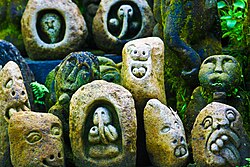

Balinese art is an art of Hindu-Javanese origin that grew from the work of artisans of the Majapahit Kingdom, with their expansion to Bali in the late 14th century. From the sixteenth until the twentieth centuries, the village of Kamasan, Klungkung (East Bali), was the centre of classical Balinese art. During the first part of the twentieth century, new varieties of Balinese art developed. Since the late twentieth century, Ubud and its neighboring villages established a reputation as the center of Balinese art.
Ubud and Batuan are known for their paintings, Mas for their woodcarvings, Celuk for gold and silver smiths, and Batubulan for their stone carvings. Covarrubias[1] describes Balinese art as, "... a highly developed, although informal Baroque folk art that combines the peasant liveliness with the refinement of classicism of Hinduistic Java, but free of the conservative prejudice and with a new vitality fired by the exuberance of the demonic spirit of the tropical primitive". Eiseman correctly pointed out that Balinese art is carved, painted, woven, and prepared into objects intended for everyday use rather than as object d 'art.[2] Balinese paintings are notable for their highly vigorous yet refined, intricate art that resembles baroque folk art with tropical themes.[3]
- ^ Covarrubias, Miguel (1937). Island of Bali. Cassel.
- ^ Eiseman, Fred and Margaret (1988). Woodcarving of Bali. Periplus.
- ^ Forge, Anthony (1978). "Balinese Traditional Paintings" (PDF). The Australian Museum. Archived (PDF) from the original on 20 December 2016. Retrieved 20 December 2016.
© MMXXIII Rich X Search. We shall prevail. All rights reserved. Rich X Search
